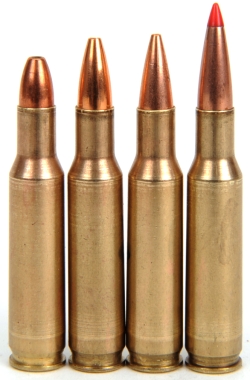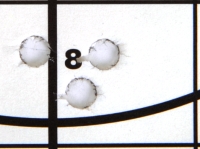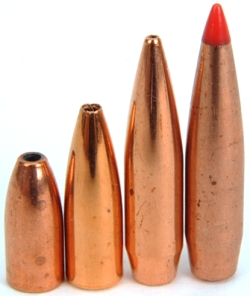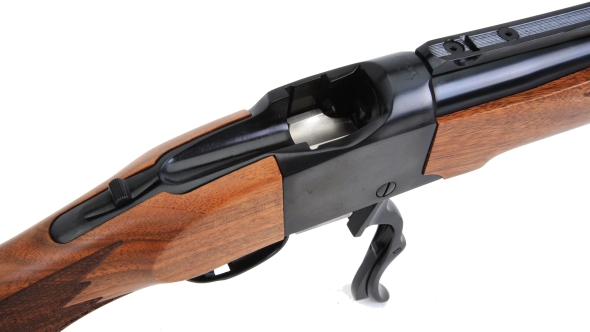Whether shooting factory ammunition, or working with handloads, the Ruger No.1 is fun. The falling block single shot is a far cry from break action single shots and it shows in reloading speed and in accuracy. The break action separates the firearm’s barrel from its receiver every time it is open for loading and empting the firearm’s chamber. The break action relies on a pivot and relatively fragile catches for lock up.
The Ruger’s falling block’s barrel and receiver remain as one. Only the breech block, precisely traveling vertically, moves to facilitate loading. The falling block action is much stronger than a break action firearm and it more consistently maintains cartridge headspace and the parallel and longitudinal alignment of the rifle’s breech face, cartridge and bore centerlines. Even this relatively lightweight Light Sporter locks up like a small bank vault.
While I have a tendency to push cartridges with strong cases, in strong rifles, toward modern high pressures, this was not the case within this effort. The 222 Remington was intended as a moderate 200 yard cartridge, leaving the long range scorching ballistics to the 22-250 Rem and 220 Swift. This intent was honored, however, there were still some opportunities to do a little heavy hitting within spec pressures.
The combination of the No.1’s 9″ twist, decent freebore and long ogive bullets permitted the use of some relatively heavy, well stabilized 0.224″ bullets. There were a few surprises. My optimistic forecast of great things from Re10x was not substantiated by the chronograph. Overall, this combination of Ruger No. 1 and 222 Remington made for an excellent range day. The report was mild, recoil was virtually non-existent and, physically, the Ruger No.1 was a comfortable rifle to shoot.
A small gun with very big bullets…
| Bullet |
Type |
Weight
Grains |
Length
Inches |
B.C. |
C.O.L.
Inches |
Net Capacity
Grains |
| Remington |
FBHP |
45 |
0.516 |
0.132 |
1.995 |
24.7 |
| Berger |
FBHP |
50 |
0.716 |
0.200 |
2.130 |
24.1 |
| Hornady |
BTHP |
68 |
0.985 |
0.361 |
2.130 |
21.8 |
| Hornady |
BT A-Max |
75 |
1.110 |
0.443 |
2.130 |
20.5 |
As noted previously, the 1:9″ twist permitted the use of heavier bullets and manufacturers of all of the bullets appearing on the table above indicated 9″ or tighter rifling.

Inside 100 yards, light weight, low SD – BC bullets hold an edge in trajectory but never retained energy. Beyond 100 yards, heavier high SD – BC bullets have a clear edge in all ballistic indicators.
Something to consider… the little 222 Remington puts more energy on target than the venerable deer slaying 30-30 WCF from 100 yards on out.
|
Remington 45 Grain +/-3″ 260 Yards Point Blank
|
|
Yards
|
0
|
100
|
200
|
300
|
|
Velocity – fps
|
3400
|
2659
|
2028
|
1502
|
|
Energy – ft.-lbs.
|
1155
|
706
|
411
|
225
|
|
Momentum – lbs-sec
|
0.68
|
0.53
|
0.40
|
0.30
|
|
Path – in.
|
-1.5
|
2.5
|
1.5
|
-8.2
|
|
Hornady 75 Grain +/-3″ 267 Yards Point Blank
|
|
Yards
|
0
|
100
|
200
|
300
|
|
Velocity – fps
|
2700
|
2499
|
2308
|
2125
|
|
Energy – ft.-lbs.
|
1214
|
1040
|
887
|
752
|
|
Momentum – lbs-sec
|
0.90
|
0.83
|
0.77
|
0.71
|
|
Path – in.
|
-1.5
|
2.8
|
1.4
|
-6.4
|
No, I am not suggesting that we all run for the 222 Remington for deer season, but I am suggesting that it is a powerful small bore that is adequate for a varmints, small to medium size game and it would probably make for a good hog cartridge.
Handloads
Powder choices, theoretically, looked to be broad but, in actuality, not so much. I didn’t care for IMR 4227. It was too fast to develop velocity with heavier bullets. IMR 3031 and IMR 4198 did not generate velocity commensurate with peak pressure, so I guess the issue was the pressure curve rather than peak. Below is what I felt was worth detailing.
|

|
Warning: Bullet selections are specific, and loads are not valid with substitutions of different bullets of the same weight. Variations in bullet length will alter net case capacity, pressure and velocity. Primer selection is specific and primer types are not interchangeable. These are maximum loads in my firearms and may easily be excessive in others. All loads should be reduced by 5%, and developed following safe handloading practices as represented in established reloading manuals produced by component manufacturers. Presentation of these loads does not constitute a solicitation for their use, nor a recommendation.
|
Cartridge: 222 Remington
|
|
Rifle: Ruger No.1
|
Max COL: 2.130″
|
|
Bullet Diameter: 0.224″
|
Primer: CCI 400
|
|
Barrel: 22″
|
Reloading Dies: Lee Precision
|
|
Max case length: 1.700″
|
3 Shot Group: 50 yards
|
| – |
|
|
Bullet
|
Bullet Weight
Grains
|
Net Water Capacity
|
COL”
|
|
Powder Type
|
Powder Charge
Grains
|
Muzzle Velocity
FPS |
Muzzle Energy
Ft-Lbs
|
Group Size
3 Shot “
|
| Remington FBHP |
45 |
24.7 |
1.995 |
|
Re7 |
22.0 |
3400 |
1155 |
1.2 |
| Remington FBHP |
45 |
24.7 |
1.995 |
|
Re10x |
22.5 |
3384 |
1145 |
1.3 |
| Berger FBHP |
50 |
24.1 |
2.130 |
|
Re10x |
22.0 |
3288 |
1201 |
0.8 |
| Berger FBHP |
50 |
24.1 |
2.130 |
|
Benchmark |
23.0 |
3141 |
1096 |
0.7 |
| Hornady BTHP |
68 |
21.8 |
2.130 |
|
Re10x |
19.0 |
2809 |
1192 |
1.0 |
| Hornady BTHP |
68 |
21.8 |
2.130 |
|
RS TAC |
22.0 |
2858 |
1234 |
1.2 |
| Hornady BT A-Max |
75 |
21.5 |
2.235* |
|
Re 10x |
19.0 |
2700 |
1214 |
0.8 |
| Hornady BT A-Max |
75 |
21.5 |
2.235* |
|
Benchmark |
20.5 |
2673 |
1190 |
0.5 |
|
*
Exceed SAAMI limit for maximum cartridge overall length
|

That is a 1″ square grid target, holes in this case courtesy of Hornady and Hodgdon Benchmark powder. I did baseline with Remington Express 50 grain Core-Lokt. It cranked out 3,151 fps compared to a rated 3,140 fps and put up a 1.1″ 3 shot group. I’m on my eight or so Ruger No.1 and I am still waiting for the one that is suppose to be inaccurate.
The groups indicated were shot from a rest, with the rest under the rifle’s forearm… as would be the case when shooting from a standing position. There were no signs of stringing or scattering or any other malady that could be attributed to the rifle.
As Terence Aloysius ‘Slip’ Mahoney would say, “So in contusion….”
The Ruger No.1 Light Sporter is a terrific little rifle, well made and an excellent cartridge selection for the 2013 production of this model. Not to be confused with the 22 Hornet where limited range and low report are paramount, the 222 Remington is a versatile 22 centerfire with lots of reach for the range and hunting.







Email Notification